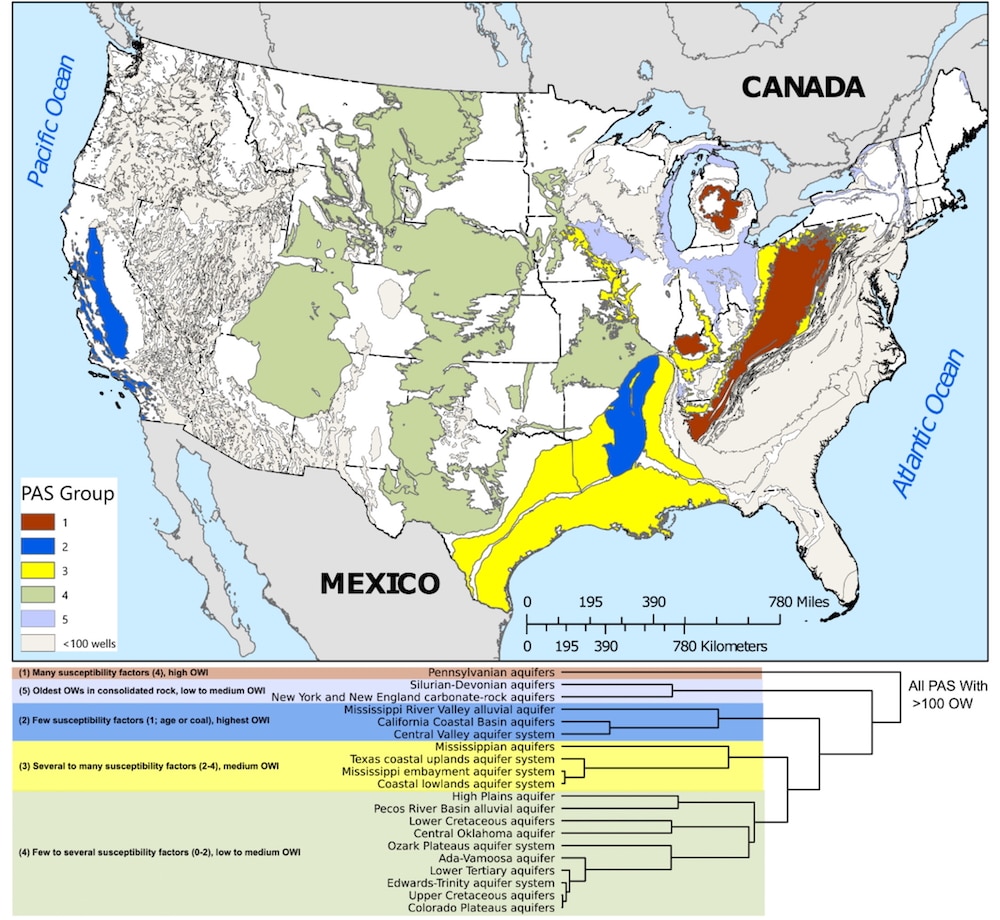This post was originally published on Eco Watch
Scientists from the United States Geological Survey (USGS) have for the first time compiled a map of groundwater variables to understand which aquifers in the United States are most vulnerable to being contaminated by “orphan wells” — gas and oil wells that have no active owner and are no longer producing, but have not yet been plugged.
The study, “A geospatial analysis of water-quality threats from orphan wells in principal and secondary aquifers of the United States,” was published in the journal Science of the Total Environment.
“Throughout the history of oil and gas production in the United States, millions of wells have been drilled for exploration and energy production. Hundreds of thousands of unplugged wells are no longer actively producing and are currently under orphan status, with no responsible party obligated for plugging,” the authors wrote in the findings. “Orphan wells can pose threats to water resources by providing pathways for contaminants such as hydrocarbons and brines to migrate into water-supply aquifers.”
Plugging the orphan wells seals off potential pathways for the contaminants, reported Inside Climate News.
USGS scientists Joshua Woda, Nicholas Gianoutsos, Kalle Jahn, Kristina Gutchess and Karl Haase found that large concentrations of older orphan wells, along with other factors, make aquifers in California, Appalachia and the Gulf Coast susceptible to contamination.
The researchers examined 117,672 documented orphan wells across the U.S. and found that 54 percent of them are located within aquifers that provide 94 percent of the country’s groundwater.
“No matter where you live across the nation, you can go look at what’s happening in your backyard, how your aquifers compare to other aquifers and what the threats are,” Gianoutsos said, as Inside Climate News reported.
The research team used datasets from Geographic Information Systems to map the orphan wells’ locations over both principal and secondary aquifers. Their analysis of the aquifers was based on factors — like average age of the wells — that could contribute to how vulnerable to contamination the groundwater was.
Older wells are more failure-prone and less regulated. The “maximum confluence” of risk factors was found in Pennsylvanian aquifers, which span multiple states in Appalachia, including Pennsylvania, where the first of the country’s oil wells were drilled.
Orphan wells can be more than a century old and found near coal seams as well as residential water wells.
The team found that aquifers along the Gulf Coast, including the aquifer system known as Coastal Lowlands, were susceptible partially because the wells are found in areas such as open water and wetlands, which are more contamination-prone.
In Coastal California and the Central Valley, there is a high density of abandoned orphan wells that overlaps with areas that have been urbanized and rely heavily on groundwater for agriculture. In these areas, the researchers considered pumping rates from each aquifer in their analysis.
They discovered that central Oklahoma’s Ada-Vamoosa aquifer had the highest orphan well concentration per square mile of all the aquifers in the U.S.
A map of locations with vulnerability to groundwater contamination due to orphaned wells. Science of the Total Environment
The authors of the paper suggested that researchers and policymakers could use the findings as a basis for targeting aquifers for further investigation.
“This could be a good starting point if someone wanted to do a local investigation,” Woda noted.
Gianoutsos said the national list of orphan wells has added approximately 40,000 orphan wells since their new dataset was created. An additional roughly 10,000 orphan wells have also been plugged.
“The threats are still there,” Gianoutsos said. “Just as we discover more wells, we discover additional threats.”
Orphan wells have been associated with groundwater contamination in Ohio, Texas, Pennsylvania and other states. A Ground Water Protection Council study from 2011 found that 41 incidents of contaminated groundwater were caused by Ohio orphan wells between 1983 and 2007. The study also discovered that orphan wells and surrounding sites caused 30 incidents in Texas from 1993 to 2008.
John Stolz, a Duquesne University professor of environmental microbiology, said some Pennsylvania orphan wells are so old that they are cased with metal or wood rather than cement, as has been the standard for decades, reported Inside Climate News. He said the wood casings have often completely deteriorated.
Stolz said recent fracking and conventional drilling have left much of Pennsylvania’s lands “looking like Swiss cheese.”
“It’s good to see a study that focuses on the water resources,” Stolz said. “We are going to have greater periods of drought, and these water resources are going to become far more valuable.”
The post Scientists Map Where Orphan Wells Threaten Aquifers in the U.S. appeared first on EcoWatch.




0 Comments